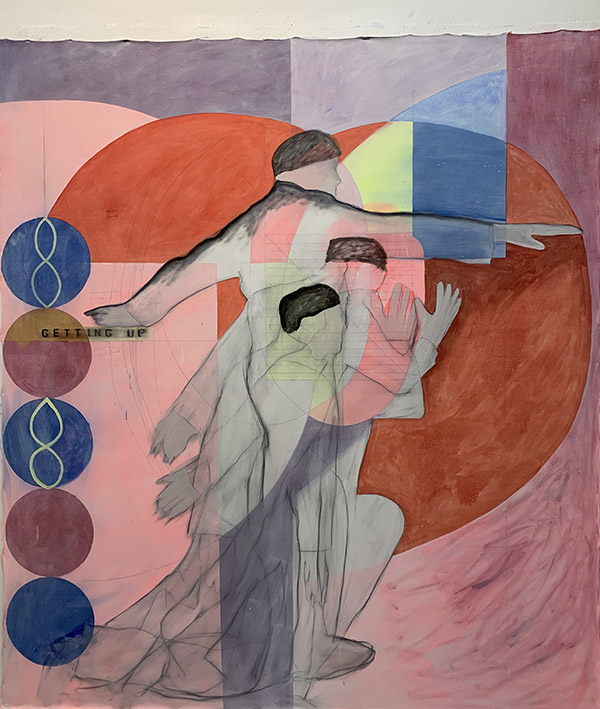Craig Stockwell: memorials (observed)
Jaffrey Civic Center • Jaffrey, NH • jaffreyciviccenter.com • Through June 4, 2022

When this writer first saw Craig Stockwell’s work years ago, it was filled with curving, amoeba-like shapes: an influence of Miro and Gorky yet uniquely interpreted. Since then, his work has evolved to include layered forms with implicit figures, with much of the recent work affected by Covid-19. The Jaffrey Civic Center is the first to exhibit his powerful series of large memorials (observed).
John’s Body from 2021 doesn’t actually show a figure, though that will evolve in the next few paintings. Here the amoeba-like shapes have been contained in a tangle of floating forms in pink and green, connected by a yellow line winding through at least two layers of space. Stockwell’s work is richly painted, and the colors are sensuous and warm, even the greens.
In Naked, beneath the green wobbly shapes in the foreground, the pink coalesces into the back of a standing nude male with outstretched hands. Is this a call for order? Do the “amoeba” forms represent germs? As is often true of abstraction, forms can resonate with multiple meanings.
In this series, Stockwell moves from painting to painting, evolving the spatial layering and symbolism with each work. In a few of these, we observe overlapping figures that are “rising” or “falling.” In Falling, three figures in a light gray-brown, fall forward ahead of a darker, mysterious figure in the background. This is followed in the next painting with figures “getting up” against a background of pink and red abstracted circles. Two of the blue circles have lighter infinity shapes. Does this suggest an eternal hope of rising from difficult times?
Stockwell uses color and form beautifully. Smaller canvases sometimes embellish the sides of larger works, as in Dickenson, with purple and lace, and Gustav Carlson, with gridded lines in green and blue, a narrative of the frozen death of his great-grandfather in 1909.
There are other, smaller, and more geometric paintings scattered through the Cunningham Galleries of the JCC. In these, Stockwell plays with hard edges versus more painterly bursts of color: a contrast of intellect, perhaps, against emotions. These are exciting paintings that connect a fluid geometry with figures reaching out to establish themselves in the unknown. Even as the fear and mysteries of Covid-19 wane, these paintings offer hope to those humans reaching out.
—Susan Wadsworth
